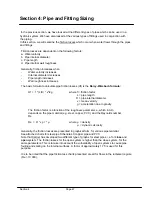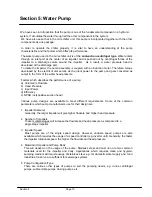
Valve Sizing
In selecting the suitable valve to use for an application, the following items must be
considered:
1. What is the fluid medium of usage.
In chillers, the fluid is water. There are valves specially designed other fluids e.g. steam and
air, which are not suitable for water.
2. What is maximum operating pressure and temperature.
3. What is the valve duty required - is it for throttling, shut-off, balancing, mixing, etc.
4. What is the pipe size to be connected
Do not oversize or undersize a valve to suit the pipe size. Size the valve according to the
flow requirements. Use reducers where applicable.
5. What is the flow rate required through the valve
6. What is the flow characteristics required - linear, equal percentage (See following pages)
7. What is the piping connection method to the valve - threaded, flanged
Most of the above mentioned information may be obtained from the valve catalogs provided
by the valve manufacturers.
In sizing the valve, the general accepted method is by means of the
C
v
(flow coefficient).
Different valves will have different C
v
values.
Formula:
Q = C
v
* (
∆
p)
Definition: The C
v
rating of any valve is the amount of water,Q (GPM) at standard conditions
(60°F, specific graviti = 1) which will pass through the valve with a pressure drop,
∆
p of 1 psi
with the valve in a full open position.
By using conversion factors, we can have the
flow coefficient K
v
in metric units:
1 C
v
= 0.857 K
v
Definition: The K
v
rating of any valve is the amount of water (m
3
/hr) at standard conditions
(20°C, specific graviti = 1) which will pass through the valve with a pressure drop of 1 kg/cm
2
with the valve in a full open position.
If the reference pressure is 1 bar, then:
1
C
v
= 0.867 K
v
Section 3
Page 58
Summary of Contents for AC 40A
Page 1: ...AM MAC ...
Page 153: ...Appendix 1 ...
Page 154: ...Appendix 2 Appendix 2 ...
Page 157: ...GRAPH OF PRESSURE DROP VS FLOW FOR VARIOUS C V RATINGS Appendix 5 1 ...
Page 158: ......
Page 159: ...Water Capacity Graph Appendix 5 2 ...
Page 160: ...CHART 3 FRICTION LOSS FOR CLOSED PIPING SYSTEMS Appendix 6 1 ...
Page 161: ...CHART 4 FRICTION LOSS FOR OPEN PIPING SYSTEMS Appendix 6 2 ...
Page 162: ...CHART 5 FRICTION LOSS FOR CLOSED AND OPEN PIPING SYSTEMS Appendix 6 3 ...
Page 168: ...Appendix 8 Appendix 8 ...
Page 169: ...Appendix 8 1 ...
Page 170: ...Appendix 8 2 ...
Page 171: ...Appendix 8 3 ...
Page 172: ...Appendix 8 4 ...
Page 173: ...Appendix 8 5 Appendix 8 5 ...
Page 174: ...Appendix 8 6 Appendix 8 6 ...
Page 175: ...Appendix 8 7 Appendix 8 7 ...
Page 176: ...Appendix 9 ...
Page 178: ...Appendix 11 1 Appendix 11 1 ...
Page 179: ...Appendix 11 2 Appendix 11 2 ...
Page 180: ...Appendix 13 ...
Page 181: ...Appendix 13 1 ...
Page 182: ...Appendix 14 Appendix 14 ...
Page 183: ...Appendix 15 1 Appendix 15 1 ...
Page 186: ...Appendix 17 Appendix 17 ...
Page 187: ...Appendix 18 ...
Page 188: ...CE20DW CE25DW Note PRESSURE DROP CORRECTION FACTOR 1 2947 0 0021 EWTºF Appendix 19 ...
Page 189: ... 2003 McQuay International 603 55194922 www mcquayup com ISO 9002 REGISTERED ...
















































